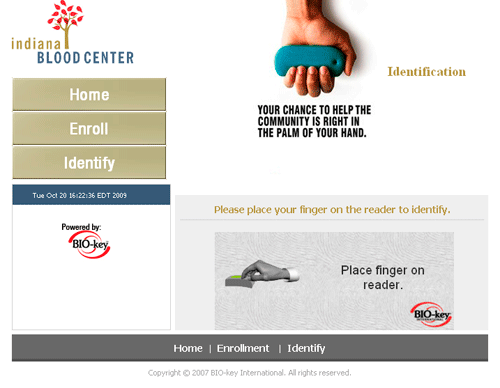Indiana blood bank uses biometrics for donor ID
18 November, 2009
category: Biometrics, Health, Library
 The Indianapolis-based Indiana Blood Center had a problem. Regulations required that blood donors be positively identified each time they donated blood, but the problem was donors don’t always have their government-issued identification card, such as a driver license.
The Indianapolis-based Indiana Blood Center had a problem. Regulations required that blood donors be positively identified each time they donated blood, but the problem was donors don’t always have their government-issued identification card, such as a driver license.
“You would be surprised how annoyed people would be when they couldn’t give blood,” says Pete Lux, manager of blood collection at the not-for-profit blood bank.
Forgetting IDs wasn’t the only problem either. Data entry errors were leading to duplicate records and it came down to names and date of birth weren’t good enough for record keeping, says Lux. The center had been storing Social Security numbers, a practice it wanted to stop to ease identity theft concerns.
The Indiana Blood Centers collect from approximately 500 donors per day at 10 fixed sites and has the capability to conduct 30 blood drives a day. The center had must comply with identification regulations from the Food and Drug Administration and the European Union because it sends blood plasma overseas.
The blood center was looking at three identification options: maintain the current system, issue their own ID card or move to a biometrics-based system, Lux says. Since the current system wasn’t working very well and issuing ID cards would have been too expensive biometrics won out. “It’s easy and always with a donor, unlike an ID card,” Lux says.
After deciding on biometrics, the blood center evaluated modality options and decided to adopt a fingerprint system. They selected Bio-Key because the company enabled the center to choose any type of fingerprint scanner. This center wanted to be able to pick different fingerprint scanners because some would be used in the field at blood drives and had to be ruggedized, Lux says.
When enrolling into the biometric system, the donor presents a government ID and scans both index fingers three times. The Bio-Key system then assigns a donor ID number, Lux says, which is used to identify that donor in the blood center’s system.
On return the donor just needs to submit the fingerprint and the information is pulled up in the system. The biometric solution had virtually eliminated clerical errors, reduced check-in times and lowered overall operating costs.
Lux recommends getting the staff’s opinion before deploying and then spending some extra time training them on the system before introducing it to donors. Making sure they are comfortable with how it works makes it easier for them to use and leads to a better customer experience.
So far the Indiana Blood Center has enrolled 20,000 donors into the voluntary system. If a donor doesn’t want to register his fingerprints he just needs to bring a government ID on each visit.
The center did have to combat some misperceptions about the technology and how it was going to be used, Lux says. “Be prepared for the conspiracy theorists,” he says. “Some people thought we were sending their fingerprints and DNA to the FBI.”



